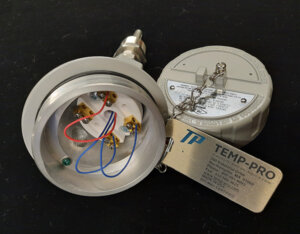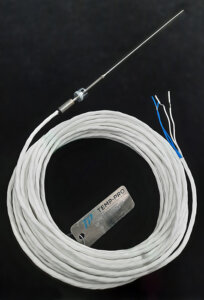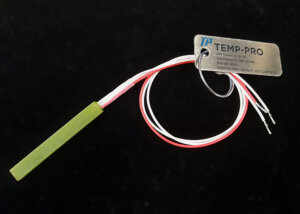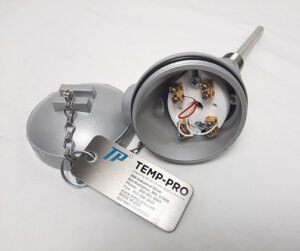In the precision-driven world of industrial temperature measurement, selecting between 3-wire and 4-wire Resistance Temperature Detectors (RTDs) involves a nuanced understanding of their technical intricacies. With Temp-Pro’s long-standing expertise since 1972, we offer a deep dive into the technical specifications of these two configurations, aiming to provide a detailed guide for professionals navigating this crucial decision.
Technical Configuration and Resistance Compensation
 3-Wire RTDs
3-Wire RTDs
These RTDs are configured with an additional lead wire to partially compensate for lead wire resistance effects where one side of the element has one wire connected and the other side has two wire connections. This setup, typically employing Kelvin connections, enhances the accuracy over the 2-wire configuration by mitigating the resistance introduced by the length and temperature coefficient of the lead wires.
4-Wire RTDs
The 4-wire configuration employs a true Kelvin bridge design. Two wires carry the measuring current, while the other two are connected to a high-impedance measurement device to detect the voltage drop across the RTD sensor. This arrangement completely eliminates the effect of lead wire resistance on the measurement, thereby providing the highest level of accuracy.
Accuracy Assessment in Varied Temperature Environments
3-Wire RTDs
Suitable for moderate-accuracy requirements, 3-wire RTDs are effective in applications where temperature fluctuations lead to changes in lead wire resistance. They are designed to compensate for the resistance variation due to temperature increases, ensuring better accuracy than 2-wire systems but not as high as 4-wire systems.
 4-Wire RTDs
4-Wire RTDs
In environments where precision is paramount, 4-wire RTDs offer optimal performance. They are immune to the changes in lead wire resistance due to temperature variances or cable length, making them ideal for applications where even minimal temperature discrepancies are critical.
Economic Factors and Wiring Complexity
3-Wire RTDs
These RTDs strike a balance between cost and performance. The additional wire does increase material and installation costs slightly compared to 2-wire systems but remains more economical than the 4-wire configuration, especially considering the reduced need for highly sensitive measurement instruments.
4-Wire RTDs
The superior accuracy of 4-wire RTDs comes with a higher price tag. The complexity of their wiring requires more sophisticated and sensitive temperature transmitters and instrumentation, leading to increased overall system costs.
 Optimal Application Environment
Optimal Application Environment
3-Wire RTDs
Commonly employed in general industrial settings where high accuracy is not the primary concern, 3-wire RTDs are well-suited for applications like HVAC control, mid-level process monitoring, and bulk temperature measurements.
4-Wire RTDs
Essential in high-precision applications, 4-wire RTDs are the go-to choice in sectors such as semiconductor manufacturing, pharmaceuticals, and scientific research, where temperature measurement precision can impact the quality and integrity of products or research outcomes.
Installation and Calibration Considerations
3-Wire RTDs
Installation of 3-wire RTDs is more straightforward than the 4-wire systems but requires careful routing and connection of the third wire to ensure effective resistance compensation. Calibration can be less demanding, as the partial compensation for lead resistance reduces the impact on accuracy.
4-Wire RTDs
The installation of 4-wire RTDs requires meticulous attention to detail, ensuring that the pair of wires used for measuring voltage are correctly connected to the high-impedance measurement device. Calibration of these sensors typically involves high-precision instruments to account for their heightened sensitivity and accuracy.
 In conclusion, when it comes to choosing between 3-wire and 4-wire RTDs for industrial temperature measurement, it’s essential to weigh the technical aspects against the practical needs of your application. Temp-Pro’s expertise in RTD technology is at your disposal to guide you through this decision. For detailed technical advice or to explore our range of RTD solutions, please contact us. Partner with Temp-Pro for tailored solutions that harmonize accuracy and cost in your temperature monitoring systems.
In conclusion, when it comes to choosing between 3-wire and 4-wire RTDs for industrial temperature measurement, it’s essential to weigh the technical aspects against the practical needs of your application. Temp-Pro’s expertise in RTD technology is at your disposal to guide you through this decision. For detailed technical advice or to explore our range of RTD solutions, please contact us. Partner with Temp-Pro for tailored solutions that harmonize accuracy and cost in your temperature monitoring systems.



